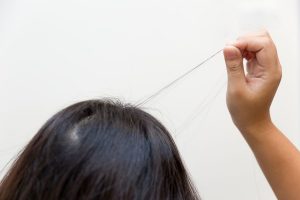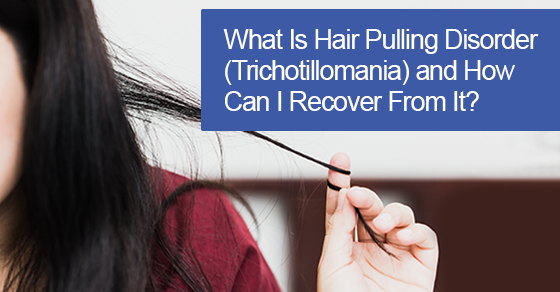What Is Hair Pulling Disorder?
 Hair Pulling Disorder involves repetitive pulling out of hair from the full range of areas in which hair grows, such as from one’s scalp, eyebrows, eyelashes, beard, mustache, arms, underarms, legs or anywhere on the body resulting in hair loss. People often pull from more than one area of their body. The most frequent pulling areas are the scalp, eyebrows, eyelashes and pubic hair. Some people ingest the pulled hair or part of the pulled hair after pulling it. Hair Pulling Disorder usually begins in late childhood or early puberty beginning at 11 – 12 years of age. However it can begin at any age including early childhood. In childhood, it occurs about equally in boys and girls. By adulthood, 80-90% of reported incidents are women. Hair pulling varies in its severity, location on the body, and in its response to treatment. Research indicates that hair pulling disorder occurs in approximately 1 in 50 people.
Hair Pulling Disorder involves repetitive pulling out of hair from the full range of areas in which hair grows, such as from one’s scalp, eyebrows, eyelashes, beard, mustache, arms, underarms, legs or anywhere on the body resulting in hair loss. People often pull from more than one area of their body. The most frequent pulling areas are the scalp, eyebrows, eyelashes and pubic hair. Some people ingest the pulled hair or part of the pulled hair after pulling it. Hair Pulling Disorder usually begins in late childhood or early puberty beginning at 11 – 12 years of age. However it can begin at any age including early childhood. In childhood, it occurs about equally in boys and girls. By adulthood, 80-90% of reported incidents are women. Hair pulling varies in its severity, location on the body, and in its response to treatment. Research indicates that hair pulling disorder occurs in approximately 1 in 50 people.
Hair pulling tends to be a chronic condition that can come and go over the course of one’s life. It can cause intense distress and shame as it can result in significant hair loss. Due to shame and embarrassment, individuals not only try to cover up the effects of their pulling behaviour but may avoid activities and social situations which could lead them to feel vulnerable to being discovered. Hair pulling can lead to tension and strained relationships with family members and friends. Hair Pulling Disorder can lead to itching, infection, scarring and if the hair is ingested, there can be a risk of gastrointestinal distress caused by a build-up of hair in the digestive tract. Approximately 30 percent of people who pull their hair eat the hair.
Why do people pull their hair?
The exact causes of Hair Pulling Disorder are not well understood. Biological, genetic and environmental factors play a role in its development making people more vulnerable to Body-Focused Repetitive Behaviours. People pull their hair for various reasons. People may pull out of boredom and may not be aware of their pulling or they may pull with intension. People may pull to try to cope with negative emotions. Ultimately the function varies between people but it is often a means to self-regulate when difficult emotions arise. Hair pulling behaviour can come with feelings of pleasure, relief and less boredom but it is often followed with unwanted emotions such as anxiety, anger, shame, sadness, feelings of unattractiveness, low self-esteem and secrecy. Due to the shame and embarrassment people may go to great lengths to cover up or camouflage the effected areas with clothing or makeup.
Which behavioural treatment methods may be used for Hair Pulling Disorder?
Research into treatment for Hair Pulling Disorder has grown over the past decade. Numerous research studies demonstrate their effectiveness. Although no particular treatment has been found to be effective for everyone, a number of evidence-based treatment options show promise for many people. Behavioural therapies are among the most evidence-based treatments in the field of Body-Focused Repetitive Behaviours. Psychological interventions that have demonstrated promise for the effective treatment of Body-Focused Repetitive Behaviours include Habit Reversal Training (HRT) which has been around since the 1970s, Comprehensive Behavioural Treatment (ComB), Acceptance and Commitment Therapy (ACT), Dialectical Behavior Therapy and most recently Integrative Behavioral Therapy (IBT). Comprehensive Behavioural Treatment (ComB) is a flexible cognitive behavioural approach based on addressing the triggers that cue and maintain the hair pulling behaviour. Acceptance and Commitment Therapy (ACT) focusses on mindful awareness and changing the relationship someone has with their inner experiences and lessening the impact it has on one’s life without the struggle. This approach promotes an increased acceptance of and tolerance for urges to pull without acting on them. When one understands and experiences their urges without responding to them it can be quite liberating. The goal of Integrative Behavioral Therapy is to improve the quality of one’s life by changing one’s relationship to their Body-Focused Repetitive Behaviour experiences and maximize the tools to most effectively manage them.

At Cognitive Behaviour Therapy Toronto I combine all of these behavioural treatment methods to assist my clients with their hair pulling issues in an individually tailored plan that incorporates cognitive behavioural strategies. Family involvement in treatment may be included to assist family members in learning how to best support their loved one. Treatment for your body-focused repetitive behaviour can give you, as it has for others, the tools to change your behaviour patterns and modify your thoughts and feelings that have fueled your hair pulling. Your unique sensory sensations, ideas, thoughts, beliefs, emotions, motor and environmental needs will be met in other healthier and adaptive ways. Treatment is a healing process that may seem challenging but with patience and with perseverance healing is possible for the majority of individuals.
There is so much more to you than your hair. It does not define who you are or what you value in life! We might wish that hair pulling would go away on its own. However support is available when the time is right for you!
BackMemberships & Accreditations
FAQ
View AllHow does CBT help with anxiety disorders?
CBT helps people with anxiety disorders by teaching them to recognize and challenge unhelpful thoughts and gradually face feared situations. read more
What are the benefits of Cognitive Behaviour Therapy?
There are so many benefits that Cognitive Behaviour Therapy has to offer. read more










